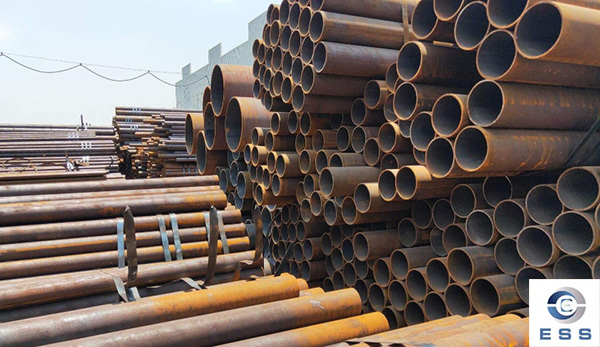Cold rolled seamless carbon steel pipe is cold drawn or cold rolled precision
seamless steel pipe with high dimensional accuracy and good surface finish for mechanical structure and hydraulic equipment. Cold rolled (drawn) seamless carbon steel pipe is divided into general steel pipe, low and medium pressure boiler steel pipe, high pressure boiler steel pipe, alloy steel pipe, petroleum cracking pipe, other steel pipes, but also includes carbon thin wall steel pipe, alloy thin wall steel pipe, special-shaped steel pipe. Hot rolled seamless carbon steel pipe diameter is generally greater than 32mm, 2.5-75mm wall thickness, cold rolled seamless steel pipe diameter can be 6mm, wall thickness can be 0.25mm, thin wall pipe diameter can be 5mm, wall thickness is less than 0.25mm, cold rolling than
hot rolling size accuracy.
The main difference between hot rolled seamless carbon steel pipe and cold rolled seamless carbon steel pipe
Difference in process
1. The section of cold-rolled steel is allowed to appear local buckling, so that the bearing capacity of the rod after buckling can be fully utilized; The hot rolled section does not allow local buckling.
2. The causes of residual stress are different between hot rolled section steel and cold rolled section steel, so the distribution on the cross section is also very different. The distribution of residual stress on the section of cold-formed thin-wall steel is of bending type, while the distribution of residual stress on the section of hot-banded or welded steel is of thin film type.
3. The free torsional stiffness of hot rolled section steel is higher than that of cold rolled section steel, so the torsional resistance of hot rolled section steel is better than that of cold rolled section steel.

Different strengths and weaknesses
Cold rolling refers to the processing of steel plate or steel strip into various types of steel after cold drawing, cold bending, cold drawing and other cold processing at room temperature.
Advantages:
forming speed, high yield, and do not damage the coating, can be made into a variety of section forms, to meet the needs of the use of conditions; Cold rolling can produce large plastic deformation of steel, thus increasing the yield point of steel.
Disadvantages:
1. Although there is no thermal plastic compression in the forming process, there is still residual stress in the section, which will inevitably affect the overall and local buckling characteristics of the steel;
2. The style of cold rolled steel is generally open section, so that the free torsional stiffness of the section is low. Torsion is easy to appear when bending, bending and torsion buckling is easy to appear when compression, and the torsional resistance is poor;
3. The wall thickness of cold rolled steel is small, and there is no thickening at the corner of plate connection, and the ability to bear localized concentrated load is weak.
Hot rolled seamless carbon steel pipe is relative to cold rolled seamless carbon steel pipe, cold rolled seamless carbon steel pipe is rolled below the recrystallization temperature, and hot rolled seamless carbon steel pipe is rolled above the recrystallization temperature.
Advantages:
It can destroy the casting structure of steel ingot, refine the grain of steel, and eliminate the defects of microstructure, so that the steel structure is dense, and the mechanical properties are improved. The improvement is mainly reflected in the rolling direction, so that the steel is no longer isotropic to a certain extent. Bubbles, cracks and looseness formed during pouring can also be welded under high temperature and pressure.
Disadvantages:
1. After hot rolling, the non-metallic inclusions inside the steel (mainly sulfide and oxide, as well as silicate) are pressed into thin slices and layered (sandwich) phenomenon occurs. Delamination greatly deteriorates the tensile properties of the steel along the thickness and may cause interlaminar tearing when the weld seams contract. The local strain induced by weld shrinkage often reaches several times of the yield strain, which is much larger than the strain caused by load.
2. Residual stress caused by uneven cooling. The residual stress is the internal self-phase equilibrium stress without external force. All kinds of hot rolled steel sections have this kind of residual stress. Generally, the larger the section size of steel, the greater the residual stress. Although the residual stress is self-phase equilibrium, it has a certain influence on the properties of steel components under external force. Such as deformation, stability, fatigue resistance and other aspects may have adverse effects.
3. It is difficult to control the thickness and edge width of hot rolled steel products. We are familiar with thermal expansion and cold contraction. At the beginning, even if the length and thickness of hot rolling reach the standard, there will still be a certain negative difference after cooling. The wider the edge width of this negative difference, the thicker the thickness, the more obvious it is. Therefore, for large steel, the width, thickness, length, Angle and edge of steel can not be required to be too accurate.













 Eastern Steel Manufacturing Co.,Ltd not only improve product production and sales services, but also provide additional value-added services. As long as you need, we can complete your specific needs together.
Eastern Steel Manufacturing Co.,Ltd not only improve product production and sales services, but also provide additional value-added services. As long as you need, we can complete your specific needs together.










